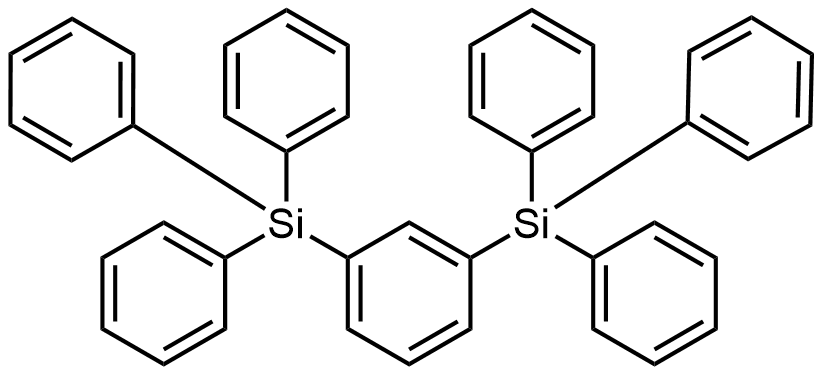The content on our website is provided solely for general informational purposes. It should not be considered, nor is it intended to provide advice or recommendations for the purchase, sale, or trade of any products or services. Importantly, the information presented does not constitute an offer to sell or a solicitation of an offer to buy any product.
Please be aware that the availability of our products may vary across different markets due to regulatory restrictions or other considerations. Consequently, not all products or services may be available in your region or country. For specific inquiries regarding the availability and pricing of any product, please contact us at sales@noctiluca.eu.
General information
-
Name:
UGH3
-
Full name:
1,3-Bis(triphenylsilyl)benzene
-
CAS number:
18920-16-6
-
Chemical formula:
C42H34Si2
-
Molecular weight:
594.89 g/mol
-
Absorption:
λmax = 265 nm in THF
-
Photoluminescence:
λmax = 418 nm
-
HOMO/LUMO:
HOMO = 7.2 eV, LUMO = 2.8 eV
-
Synonyms:
UGH-3
-
Classification:
Organic light-emitting diodes, Host materials, Hole blocking layer materials (HBL)
-
Purity:
Sublimed: >99.0% (HPLC)
-
Melting point:
46 °C
-
Appearance:
White powder/crystals
UGH3: The New Standard in OLED Material Innovation
UGH3, known scientifically as 1,3-Bis(triphenylsilyl)benzene and recognized by its CAS number 18920-16-6, is a breakthrough compound in the OLED industry. With its molecular formula C42H34Si2, UGH3 has become a key material for OLED host applications, including hole blocking layers (HBL).
Molecular Structure and Properties of UGH3
The effectiveness of UGH3 in OLED applications is deeply rooted in its unique molecular structure. UGH3, or 1,3-Bis(triphenylsilyl)benzene, is characterized by its framework consisting of a central benzene ring substituted at the 1 and 3 positions by triphenylsilyl groups. This arrangement results in a large, planar, and stable molecular structure, which is key to its properties as an OLED material.
The molecular architecture of UGH3 facilitates effective pi-conjugation, which is crucial for electronic applications. The extended conjugation system allows for efficient charge carrier mobility, enhancing the material’s ability to transport electrons and holes. This characteristic is reflected in its notable HOMO level of 7.2 eV and LUMO level of 2.8 eV, positioning UGH3 as an excellent material for facilitating efficient energy transfer within OLED devices.
We ensure that UGH3 is supplied with a purity greater than 99.0%, as confirmed by HPLC analysis. Such high purity is essential in maintaining the performance and consistency of OLEDs. The high purity of UGH3 minimizes the presence of impurities that could disrupt the material’s electronic properties, thereby contributing to the reliability and efficiency of OLEDs in various applications.
Key Features of UGH3
- Advanced Electronic Stability: UGH3’s stable electronic structure is a critical attribute for OLED host materials, ensuring consistent performance under diverse operational conditions. This stability is key to the longevity and reliability of OLED devices, offering manufacturers and end-users peace of mind regarding device durability.
- Optimal Energy Level Alignment: The HOMO and LUMO levels of UGH3 are ideally aligned for OLED applications, facilitating efficient energy transfer and emission. This alignment is crucial for producing high-quality OLED displays with vibrant colors and energy-efficient performance.
- Versatile Applications in OLED Technology: UGH3’s unique properties make it suitable for various roles within OLED devices. Its versatility is demonstrated in its widespread use in the industry, enabling the development of innovative and more adaptable OLED designs.
The Role of UGH3 in OLED Advancement
In the competitive field of OLED technology, UGH3 stands out with its ability to enhance device efficiency and lifespan. Its molecular structure and electronic properties align perfectly with the needs of advanced OLED technologies, ensuring that OLED devices are not only effective but also demonstrate improved durability and energy efficiency. The incorporation of UGH3 in OLEDs contributes to superior charge carrier balance, a key factor in maximizing the luminous efficiency of these devices. This improvement in charge carrier dynamics reduces energy losses and enhances the overall performance of OLED screens. Additionally, UGH3’s stability under operational conditions plays a significant role in extending the operational life of OLED devices, thereby reducing maintenance and replacement costs. Its compatibility with various OLED architectures opens up possibilities for innovative display technologies, further solidifying its position as a material of choice in cutting-edge OLED applications. The role of UGH3 in enabling brighter, more vibrant displays while maintaining energy efficiency aligns with the industry’s move towards sustainable and high-performing electronic devices.
Conclusion
UGH3 represents a significant step forward in OLED material science. As a material that enhances the performance and sustainability of OLED devices, UGH3 is instrumental in pushing the boundaries of organic electronics. Our commitment to providing high-quality UGH3 positions us as a leader in the OLED materials market, driving innovation and excellence in OLED technology.
